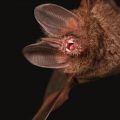The loud love calls of tiny túngara frogs (Physalaemus pustulosus) that reverberate through the nighttime jungles of Panama are bold advertisements for a suitable mate. But in singing, the frogs are taking a risk. Somewhere in the darkness an eavesdropping bat may be listening, ready to swoop down and swallow them whole.
Like the frogs, however, the bats also are taking a chance. Should a bat snatch up and swallow a poison frog in the darkness by mistake, a painful death would follow.
Now, a series of experiments conducted by scientists at the Smithsonian Tropical Research Institute in Panama have revealed that frog-eating fringe-lipped bats (Trachops cirrhosus) are, by necessity, much more discerning diners than previously known. In fact, scientists now know, from the time they begin their attack dive to just before they swallow a frog, the bats are continually evaluating their prey through such sensory modalities as sound, echolocation, touch and taste. A paper on the work is published online in the Springer journal Naturwissenschaften (The Science of Nature).
Smithsonian scientists Rachel Page, Elisabeth Kalko and their colleagues captured 8 fringe-lipped bats on Barro Colorado Island in the Panama Canal and placed them inside a large enclosure where they conducted experiments with the bats one by one, offering them a variety of frogs and toads while simultaneously playing the advertisement song of an edible túngara frog.
In one experiment they coated edible túngara frogs with secretions from a poisonous toad. When they played a túngara mating song through speakers the bats swooped down, picked up the frogs, then spit them out. Small toxic toads offered under the guise of the túngara frog’s call also were captured but dropped in flight.
Plain túngara frogs were caught and eaten by the bats.
In another experiment, the researchers offered a large cane toad with the túngara mating song. Each bat began an attack dive at the sound of the túngara song, but pulled away before reaching the toad. This suggests the bats sized-up their prey with echolocation before reaching it.
“Our study suggests that last-minute prey assessment minimizes the occurrence of costly errors,” the researchers write. “The results bring to light the sequential, complex nature of prey assessment foraging strategies that may allow exploratory and flexible hunting behaviors.”
During the study the scientists observed the bats frothing at the mouth after they had picked up a poison-coated frog. “T. cirrhosus, together with other frog-eating bats, possess unique accessory submandibular salivary glands, which may protect them from toxins and allow them to reject poisonous prey post-capture without ill effects.”
Reference: Page RA, Schnelle T, Kalko EKV, Bunge T, Bernal XE (2012). Sequential assessment of prey through the use of multiple sensory cues by an eavesdropping bat. Naturwissenschaften – The Science of Nature; DOI 10.1007/s00114-012-0920-6.






